Winter is the perfect season to transform your blonde locks into something extraordinary.
As the temperature drops and the fashion landscape shifts toward deeper, richer tones, blonde hair doesn’t have to fade into the background.
Whether you’re a natural blonde looking to enhance your color or someone who loves experimenting with new shades, this guide will walk you through the most stunning winter hair colors that will make you stand out in the cold months ahead.
From icy platinum to warm honey tones with a winter twist, we’ll explore over 25 captivating options that blend seamlessly with winter’s aesthetic while keeping your blonde base at the forefront.
You’ll discover which shades complement your skin tone, how to maintain your color through harsh winter conditions, and styling tips that will make your new hue shine brighter than fresh snowfall.
Contents
- 1 1. Icy Platinum Blonde
- 2 2. Mushroom Blonde
- 3 3. Pearl Blonde
- 4 4. Buttery Blonde
- 5 5. Silver Blonde
- 6 6. Vanilla Blonde
- 7 7. Champagne Blonde
- 8 8. Ash Blonde
- 9 9. Beige Blonde
- 10 10. Smoky Blonde
- 11 11. Rose Gold Blonde
- 12 12. Honey Blonde
- 13 13. Toasted Coconut Blonde
- 14 14. Platinum Blonde with Dark Roots
- 15 15. Wheat Blonde
- 16 16. Bronde (Blonde-Brunette Hybrid)
- 17 17. Sandy Blonde
- 18 18. Caramel Blonde
- 19 19. Frost Blonde
- 20 20. Butter Pecan Blonde
- 21 21. Dirty Blonde
- 22 22. Flaxen Blonde
- 23 23. Cool Blonde with Silver Highlights
- 24 24. Warm Champagne Blonde
- 25 25. Iced Coffee Blonde
- 26 26. Opal Blonde
- 27 27. Creamy Blonde
- 28 Maintenance Tips for Winter Blonde Hair
- 29 Choosing the Right Blonde for Your Skin Tone
- 30 Styling Tips for Winter Blonde Hair
- 31 Common Mistakes to Avoid with Winter Blonde Hair
- 32 Budget-Friendly Alternatives for Maintaining Winter Blonde
- 33 The Science Behind Blonde Hair Color
- 34 Celebrity-Inspired Winter Blonde Looks
- 35 Transitioning to Winter Blonde from Other Colors
- 36 Conclusion
1. Icy Platinum Blonde
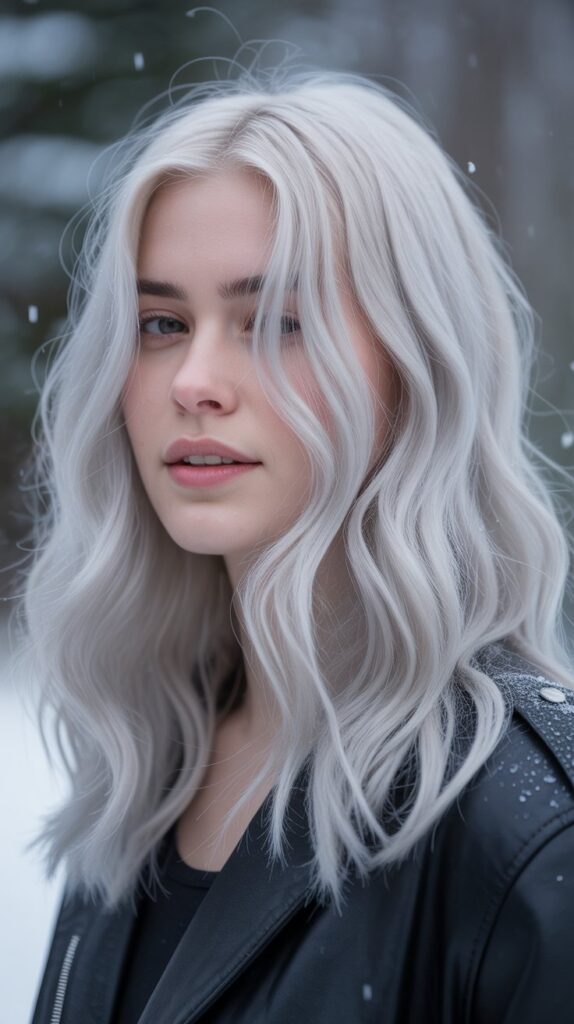
Icy platinum blonde is the ultimate winter statement color that embodies the crisp, frosty essence of the season.
This ultra-cool shade features silver-white tones that reflect light beautifully, creating an ethereal glow that’s perfect for those who want to embrace winter’s chill.
The color works exceptionally well for those with cool or neutral undertones and pairs wonderfully with winter’s fashion palette of deep blues, grays, and blacks.
- This shade requires significant lifting if you’re starting from a darker blonde, as it needs to reach the palest yellow base before toning to silver-white
- The maintenance demands are high, requiring purple shampoo at least twice weekly to prevent unwanted warm tones from developing
- Regular deep conditioning treatments become essential since achieving this level of lightness can compromise hair’s moisture balance
- Icy platinum looks stunning on cool skin tones with pink or blue undertones, creating a striking contrast that’s both modern and classic
- Consider this shade if you’re prepared for frequent salon visits every 4-6 weeks to maintain the roots and keep the color crisp
2. Mushroom Blonde

Mushroom blonde brings together the earthiness of taupe with the brightness of blonde, creating a sophisticated neutral shade that’s perfect for winter.
This color trend has gained massive popularity for its ability to neutralize brassiness while adding depth and dimension.
The shade sits beautifully between ash blonde and light brown, offering a muted elegance that complements the subdued tones of winter landscapes.
- The color combines cool gray tones with subtle beige undertones, creating a multidimensional effect that looks natural yet refined
- Mushroom blonde works exceptionally well for those transitioning from darker hair colors, as it provides excellent coverage for roots without harsh lines
- This shade requires a violet or silver toning treatment every few washes to maintain the ashy, neutral appearance
- It’s an ideal choice for neutral to cool skin tones, as the muted tones won’t wash you out or create unflattering color casts
- The low-contrast nature of mushroom blonde makes it relatively low-maintenance compared to brighter blonde shades, with touch-ups needed every 6-8 weeks
3. Pearl Blonde
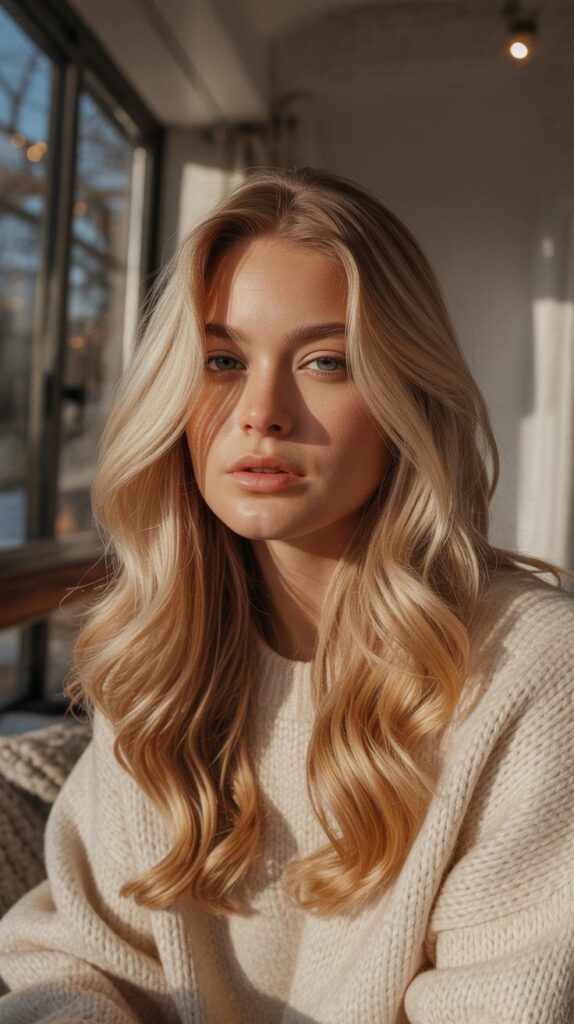
Pearl blonde is a luminous shade that captures the iridescent quality of actual pearls, blending white, silver, and the softest hints of pink or lavender.
This multidimensional color creates an otherworldly shimmer that changes appearance in different lighting conditions, making it one of the most dynamic winter blonde options.
The pearlescent effect adds luxury and sophistication to your look while maintaining the coolness that winter demands.
- Achieving pearl blonde requires pre-lightening to a very pale base, followed by specialized toners that create the iridescent finish
- The color incorporates multiple tones including silver, white, and pastel undertones that reflect light in various ways
- Pearl blonde demands careful maintenance with color-depositing conditioners specifically formulated for maintaining pastel and silver tones
- This shade photographs exceptionally well, making it popular among influencers and those who frequently document their style
- The best candidates have naturally light hair or are willing to commit to the bleaching process, as the base needs to be level 10 or higher
4. Buttery Blonde

Buttery blonde offers a warmer alternative to cooler winter blondes while still maintaining the richness appropriate for the season.
This creamy, soft yellow-toned blonde resembles the color of fresh butter, providing warmth without looking brassy or orange.
It’s perfect for those who want to embrace blonde hair in winter while maintaining a sun-kissed glow that brightens up gray winter days.
- The shade features warm golden undertones mixed with cream tones, creating a soft, approachable appearance
- Buttery blonde is more forgiving on the hair than ultra-light shades because it doesn’t require bleaching to pure white
- This color complements warm and neutral skin tones particularly well, enhancing natural warmth in the complexion
- Maintenance involves using color-safe shampoos and occasional gloss treatments to keep the buttery tone from turning brassy
- It’s an excellent choice for those who want a natural-looking blonde that doesn’t appear too processed or artificial
5. Silver Blonde

Silver blonde represents the perfect marriage between true silver gray and blonde, creating a sophisticated shade that’s both modern and timeless.
This color has become increasingly popular as more people embrace gray tones as a fashion statement rather than something to cover.
The metallic quality of silver blonde adds an edgy, contemporary element to your look while remaining elegant and refined for winter.
- True silver blonde sits darker than platinum but lighter than traditional ash blonde, occupying a unique space in the blonde spectrum
- The color requires neutralizing all warm pigments in the hair before applying silver toners to achieve the pure metallic effect
- Silver blonde works beautifully on all ages, challenging the notion that gray-toned hair is exclusively for mature individuals
- Regular toning appointments every 3-4 weeks help maintain the silver vibrancy and prevent the color from appearing dull or yellowed
- This shade pairs exceptionally well with bold makeup choices, as the neutral hair color provides a sophisticated canvas
6. Vanilla Blonde

Vanilla blonde delivers a soft, neutral shade that leans toward the warmer side without crossing into golden territory.
This shade resembles the color of vanilla bean, offering a creamy off-white appearance that’s gentler and more wearable than stark platinum.
Vanilla blonde has become a favorite for winter because it brightens the complexion without the severity of ultra-cool tones.
- The color combines pale yellow and cream tones with the slightest hint of warmth, creating a balanced neutral blonde
- Vanilla blonde is particularly flattering on light to medium skin tones with neutral undertones
- Achieving this shade typically requires lifting to a level 9 or 10, followed by a carefully balanced toner
- The maintenance is moderate, requiring purple shampoo once or twice weekly and regular glossing treatments every 6-8 weeks
- This shade photographs beautifully in natural winter light, making it ideal for those who are active on social media
7. Champagne Blonde

Champagne blonde captures the elegant, effervescent quality of the celebratory drink it’s named after.
This sophisticated shade blends pale gold with beige and the subtlest pink undertones, creating a luxurious color that’s perfect for winter celebrations and special occasions.
The multidimensional nature of champagne blonde means it catches light beautifully, creating movement and depth that flat colors simply cannot achieve.
- The color achieves its signature sparkle through a combination of warm and cool tones layered throughout the hair
- Champagne blonde requires skilled color application, often using techniques like balayage or babylights to create natural dimension
- This shade is incredibly versatile, complementing a wide range of skin tones from fair to medium-deep
- Maintaining champagne blonde involves alternating between purple and blue shampoos to balance both warm and cool tones
- The color works exceptionally well with winter’s metallic fashion trends, including gold and rose gold accessories
8. Ash Blonde
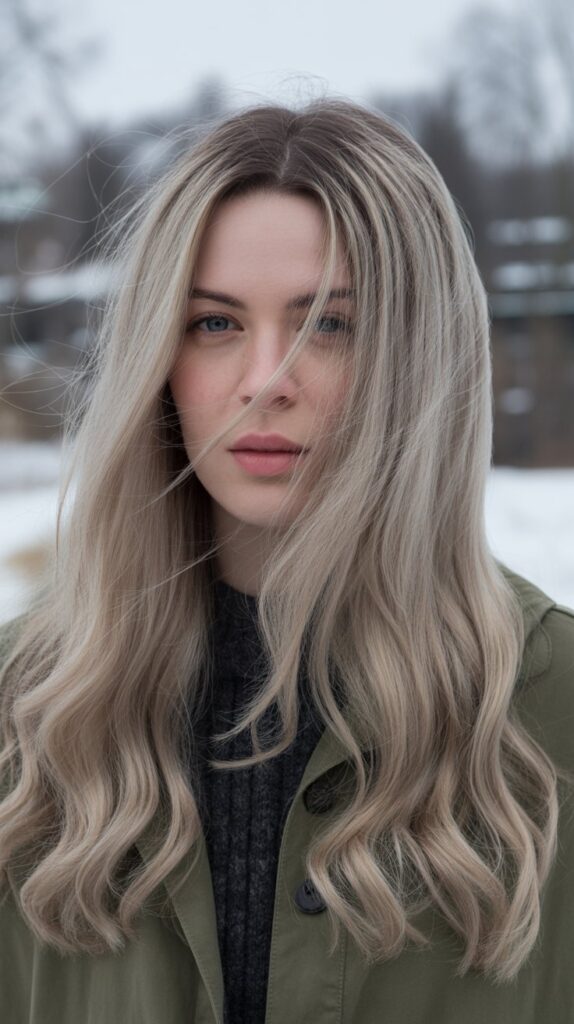
Ash blonde remains a winter staple for those who want cool-toned hair without going as extreme as platinum or silver.
This shade features gray-brown undertones that neutralize any warmth, creating a sophisticated, muted blonde that looks naturally sun-faded rather than processed.
Ash blonde has staying power in the hair color world because it offers versatility and wearability while still making a statement.
- The shade works by depositing cool pigments that counteract the warm yellow and orange tones naturally present in blonde hair
- Ash blonde is particularly suited to those with cool or neutral skin undertones, as the gray tones complement rather than clash
- This color can range from light ash to medium ash, allowing for customization based on your natural depth
- Maintenance requires purple or blue shampoo to prevent the ash tones from fading into warmer, brassier territory
- Ash blonde provides excellent gray coverage for those who are beginning to see silver hairs, blending them seamlessly into the overall color
9. Beige Blonde

Beige blonde offers a neutral middle ground that’s neither too warm nor too cool, making it one of the most universally flattering blonde shades for winter.
This color combines elements of both ash and gold, resulting in a sophisticated sandy tone that looks expensive and natural.
Beige blonde has become increasingly popular because it requires less maintenance than extreme shades while still providing a noticeable transformation.
- The shade features balanced undertones that prevent it from pulling orange in warm light or green in cool light
- Beige blonde is achievable for most natural blonde and light brown starting points without excessive damage
- This color is particularly forgiving as roots grow in, creating a natural shadow root effect rather than harsh lines
- Maintenance involves using color-safe products and occasional gloss treatments to refresh the beige tones
- It’s an excellent choice for those seeking a sophisticated, office-appropriate blonde that still feels fashion-forward
10. Smoky Blonde
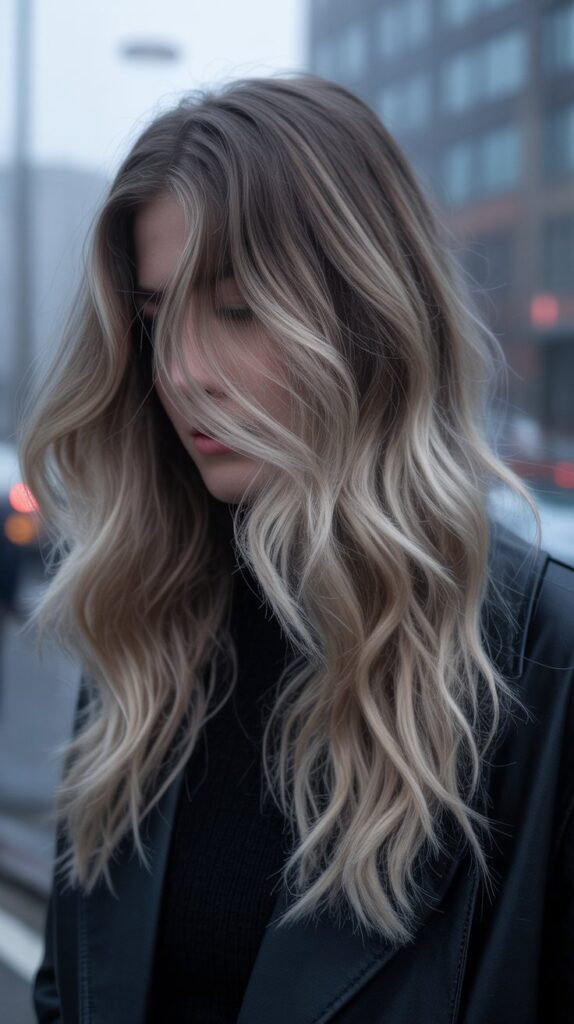
Smoky blonde combines dark roots with lighter ash or gray-toned ends, creating a dramatic yet wearable look that’s perfect for winter’s moodier aesthetic.
This shadowed effect adds depth and mystery to blonde hair while reducing maintenance needs since the darker roots are intentional rather than regrowth.
The smoky quality comes from layering cool tones throughout the lengths, giving the hair a hazy, dimensional appearance.
- The technique typically involves keeping 2-4 inches of natural root, then transitioning to cool-toned blonde through the mid-lengths and ends
- Smoky blonde requires less frequent salon visits since the dark roots are part of the design, with touch-ups needed every 8-12 weeks
- This style works exceptionally well for those with naturally darker blonde or light brown hair who want to go blonde without full commitment
- The color adds instant dimension and movement, making fine hair appear fuller and more textured
- Smoky blonde pairs beautifully with winter’s layered clothing and creates a cohesive look with scarves and outerwear
11. Rose Gold Blonde
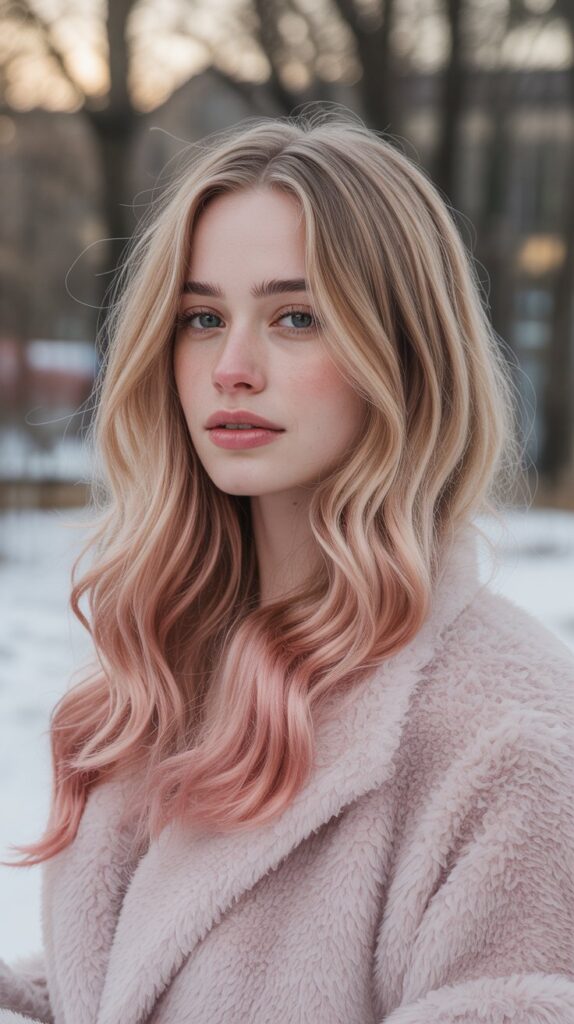
Rose gold blonde infuses traditional blonde with warm pink undertones, creating a romantic and feminine shade that softens features beautifully.
This trendy color has maintained popularity because it offers something different from standard blonde options while remaining wearable for everyday life.
The rose gold effect is subtle enough to be professional yet distinct enough to showcase your personal style during winter months.
- Achieving rose gold blonde requires a pale base followed by rose gold toner or semi-permanent color to deposit the pink tones
- The color works best on fair to light-medium skin tones, where the pink undertones enhance rather than compete with natural coloring
- Rose gold blonde fades gracefully, transitioning to softer peachy or vanilla tones rather than brassy orange
- Maintenance includes using rose gold color-depositing conditioners and avoiding excessive heat styling that can strip the delicate pink pigments
- This shade photographs exceptionally well in natural winter light and during golden hour, making it Instagram-friendly
12. Honey Blonde

Honey blonde brings natural warmth to winter hair color with its rich golden tones that resemble natural honey.
This shade offers depth and richness while maintaining the brightness that blonde hair is known for.
Honey blonde works particularly well in winter because it provides a sun-kissed glow that counteracts the season’s gray skies and limited natural light, keeping you looking radiant even on the dreariest days.
- The color features warm golden and amber undertones that create a naturally dimensional appearance
- Honey blonde is one of the most versatile shades, complementing warm, neutral, and even some cool skin tones
- This shade is relatively low-maintenance as slight fading creates a natural-looking sun-kissed effect rather than appearing brassy
- The warmth of honey blonde makes it an excellent choice for those who find cooler blondes wash them out
- It requires less aggressive bleaching than platinum shades, making it healthier for the hair overall
13. Toasted Coconut Blonde
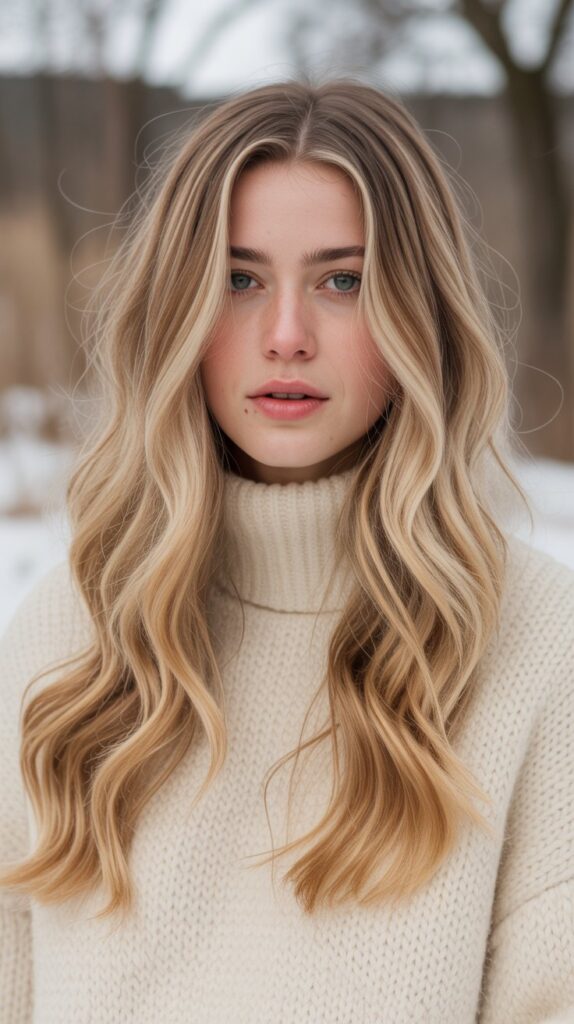
Toasted coconut blonde blends creamy vanilla tones with subtle caramel, creating a deliciously warm yet sophisticated shade.
This color mimics the appearance of coconut that’s been lightly toasted, offering depth in the roots with brighter, cream-toned ends.
The dimensional quality makes it perfect for winter, as it provides visual interest without requiring bold contrasts.
- The shade combines multiple tones including cream, beige, and light caramel to create a naturally blended appearance
- Toasted coconut blonde is achieved through techniques like balayage or foilayage that create soft transitions between shades
- This color is particularly flattering on warm and neutral skin tones, enhancing natural warmth without appearing brassy
- Maintenance is relatively low, as the multidimensional nature disguises regrowth better than solid color applications
- The color works beautifully with winter’s earth-tone fashion palette, complementing browns, creams, and camel colors
14. Platinum Blonde with Dark Roots

Platinum blonde with dark roots offers the best of both worlds—the drama of ultra-light blonde without the constant maintenance of keeping roots touched up.
This intentionally contrasted look has become a signature winter style, as the dark roots add depth and prevent the platinum from appearing flat or one-dimensional.
The shadow root technique used here creates a modern, edgy aesthetic that’s both practical and stylish.
- The style typically maintains 2-3 inches of natural root color before transitioning sharply to platinum blonde
- This approach significantly reduces maintenance time and damage, as only the platinum sections need regular toning
- Platinum with dark roots works on all skin tones, as the darker roots provide anchoring contrast that prevents washout
- The look requires commitment to maintaining the platinum sections while allowing the roots to grow naturally
- It pairs exceptionally well with bold winter makeup looks and creates striking visual impact in photographs
15. Wheat Blonde

Wheat blonde captures the natural, sun-lightened appearance of wheat fields in late summer, offering a warm yet subtle blonde shade.
This color features soft golden undertones mixed with neutral beige, creating an earthy tone that feels grounded and natural.
Wheat blonde is perfect for winter because it brings warmth without appearing artificial, offering a refreshing change from the ultra-processed looks that dominate blonde hair trends.
- The shade sits in the light to medium blonde range, making it accessible for those with naturally darker blonde or light brown hair
- Wheat blonde requires less aggressive lifting than platinum shades, resulting in healthier hair with better texture
- This color is universally flattering, working across different skin tones and ages with equal success
- Maintenance involves color-safe shampoo and occasional glossing to refresh the golden-neutral balance
- The natural appearance of wheat blonde makes it an excellent choice for professional environments and conservative dress codes
16. Bronde (Blonde-Brunette Hybrid)
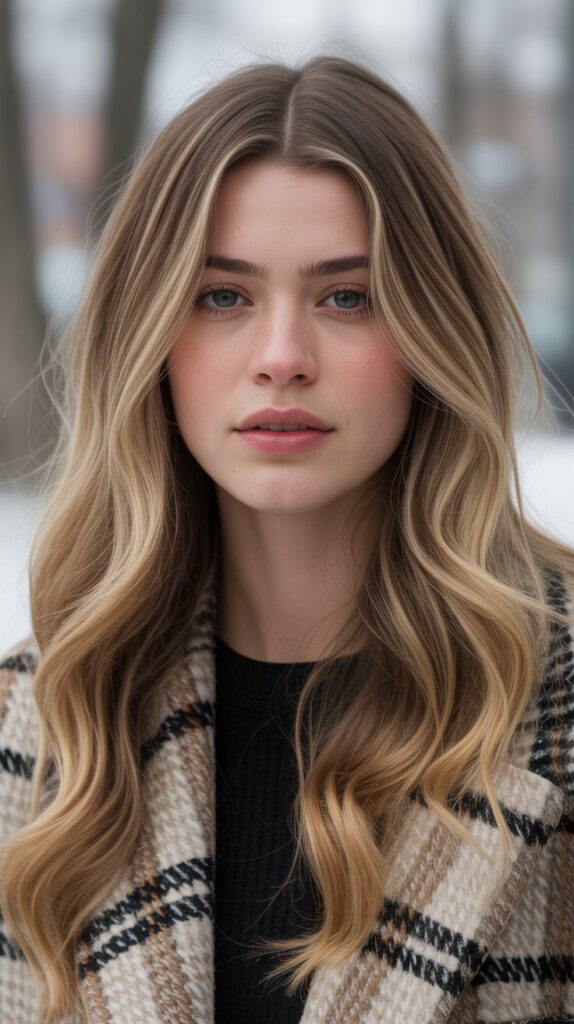
Bronde perfectly blends blonde and brunette, creating a hybrid color that offers the best features of both.
This multidimensional shade features brown roots that gradually transition through caramel and golden tones to blonde ends.
Bronde has become increasingly popular for winter because it provides warmth, depth, and dimension while remaining low-maintenance and flattering on virtually everyone.
- The color typically keeps the root area in the light to medium brown range, transitioning to blonde through the mid-lengths and ends
- Bronde is achieved through techniques like balayage, ombre, or sombre that create seamless color transitions
- This shade requires minimal maintenance, with touch-ups needed only every 10-14 weeks depending on growth rate
- Bronde works across all skin tones, as the combination of warm and cool tones creates universal flattery
- The dimensional nature adds instant volume and movement to the hair, benefiting those with fine or flat hair
17. Sandy Blonde

Sandy blonde evokes the natural color of beach sand, combining beige and gold tones with the slightest hint of brown.
This earthy, neutral blonde feels organic and effortless, making it perfect for those who want a blonde shade that doesn’t require constant explanation or maintenance.
Sandy blonde brings warmth to winter styling while maintaining the sophistication expected from the season’s color palette.
- The shade features balanced undertones that prevent it from pulling too warm or too cool in different lighting
- Sandy blonde is particularly well-suited for those with neutral skin undertones, as it harmonizes rather than contrasts
- This color is relatively low-maintenance, as slight fading creates a natural sun-kissed appearance
- Achieving sandy blonde typically requires lifting to a level 7 or 8, making it accessible without extreme processing
- The color provides excellent camouflage for gray hairs, blending them seamlessly into the overall look
18. Caramel Blonde

Caramel blonde infuses traditional blonde with rich, warm caramel tones that add depth and luxury to the color.
This shade offers more intensity than honey blonde while remaining firmly in blonde territory, creating a sweet, inviting appearance.
Caramel blonde is particularly stunning in winter, as the rich undertones complement the season’s warm neutrals and create a cozy, approachable aesthetic.
- The color combines golden blonde with deeper caramel ribbons for a multidimensional, expensive-looking result
- Caramel blonde is best achieved through dimensional coloring techniques that layer multiple shades throughout the hair
- This shade is exceptionally flattering on warm skin tones and adds warmth to neutral undertones
- Maintenance involves using sulfate-free products and occasional gloss treatments to maintain the richness of the caramel tones
- The depth of caramel blonde means it photographs beautifully in various lighting conditions, from natural to artificial
19. Frost Blonde
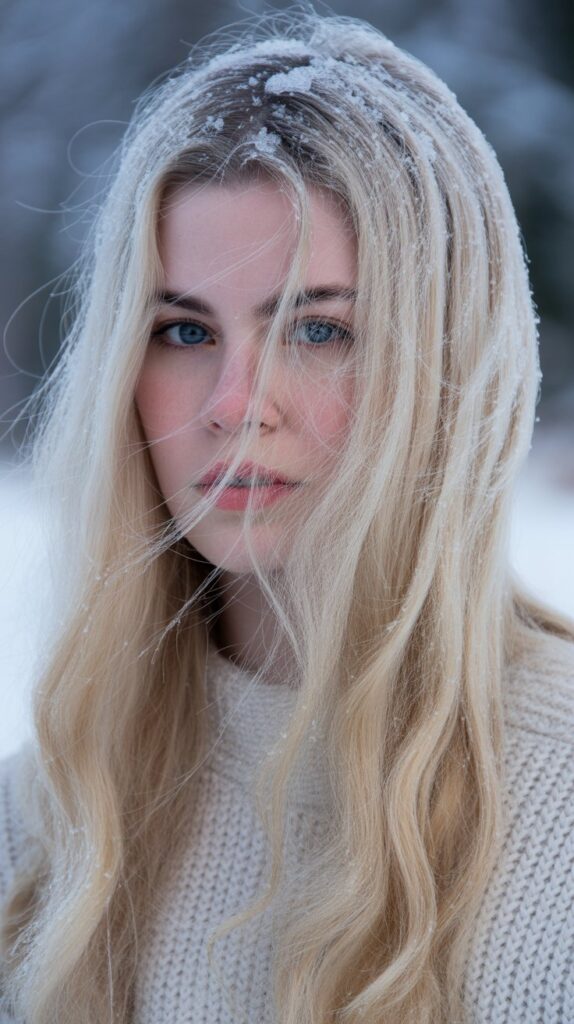
Frost blonde creates an icy, crystalline appearance by combining very pale blonde with strategic silver and white highlights.
This technique produces a frosted effect that resembles ice crystals catching winter sunlight. Frost blonde is perfect for those who want the coolness of platinum but with more texture and dimension, creating visual interest through contrasting tones.
- The style uses fine highlights or babylights to create the frosted texture throughout the base blonde color
- Frost blonde requires a very light base color, typically level 9 or 10, to accommodate the icy toner
- This shade is maintenance-intensive, requiring purple shampoo several times weekly and regular toning appointments
- The frosted effect works best on cool to neutral skin tones, creating a striking winter-appropriate appearance
- This color is ideal for those who want a unique take on platinum that offers more complexity and movement
20. Butter Pecan Blonde

Butter pecan blonde combines the warmth of buttery tones with deeper pecan-colored lowlights, creating a rich, dimensional blonde perfect for winter.
This delicious-sounding shade offers complexity through its layered warm tones, ranging from pale cream to deeper golden brown.
Butter pecan blonde brings comfort and warmth to winter styling while maintaining the brightness and lift that blonde hair provides.
- The color achieves its signature look through strategic placement of both highlights and lowlights in complementary warm tones
- Butter pecan blonde works beautifully on warm and neutral skin tones, enhancing natural warmth
- This shade is relatively low-maintenance due to its dimensional nature, which disguises regrowth effectively
- The depth variation adds instant volume and movement, making it ideal for those with fine or thin hair
- Maintenance involves color-safe products and occasional glossing to keep the warm tones from fading to brass
21. Dirty Blonde
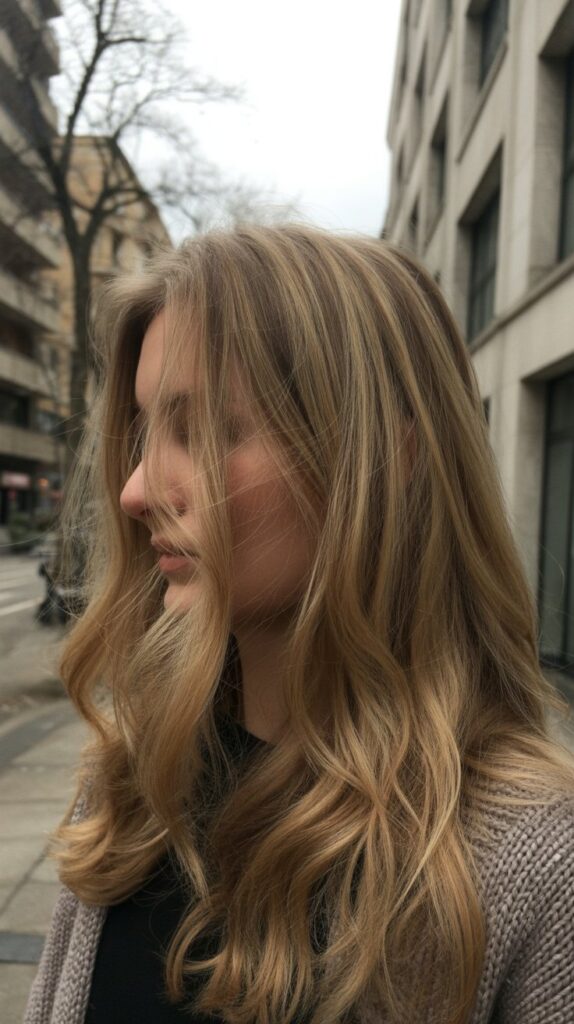
Dirty blonde embraces a more muted, lived-in appearance that combines blonde with subtle brown undertones.
This shade has gained popularity for its low-maintenance nature and natural appearance, making it perfect for those who want blonde hair without the high upkeep.
Dirty blonde captures the color that many natural blondes transition to in winter months when sun exposure decreases, making it authentically seasonal.
- The shade typically sits in the medium blonde range with ash or neutral undertones and subtle darker pieces throughout
- Dirty blonde is highly versatile, working across all skin tones and complementing various eye colors
- This color is among the lowest maintenance blonde options, often going 10-12 weeks between touch-ups
- The muted nature of dirty blonde creates a sophisticated, European-inspired aesthetic
- It’s an excellent choice for those transitioning from darker hair or looking to embrace a more natural blonde
22. Flaxen Blonde
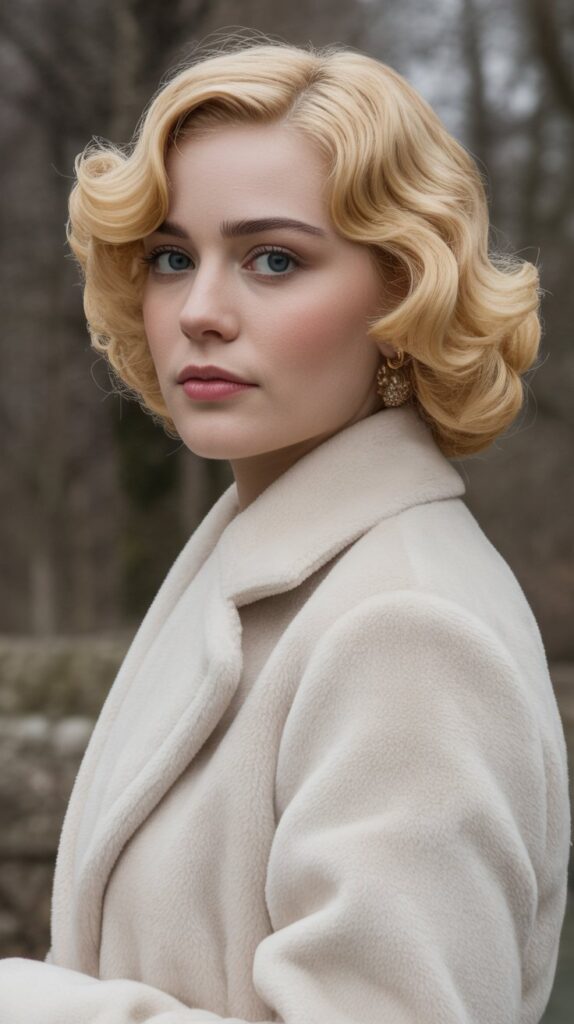
Flaxen blonde captures the pale golden color of flax fibers, offering a soft, natural-looking light blonde shade.
This color sits between platinum and golden blonde, providing brightness without the starkness of pure white or the warmth of honey tones.
Flaxen blonde has a vintage quality that feels both classic and contemporary, making it perfect for winter’s timeless fashion aesthetics.
- The shade features soft yellow undertones that create warmth without appearing brassy or orange
- Flaxen blonde is particularly flattering on those with neutral to warm skin tones and light eyes
- Achieving this color requires lifting to a level 9-10 and using specifically formulated toners to achieve the flax-like quality
- Maintenance involves using purple shampoo sparingly, as the goal is to maintain some warmth rather than neutralize it completely
- This shade works beautifully with winter’s neutral and cream-colored fashion choices
23. Cool Blonde with Silver Highlights
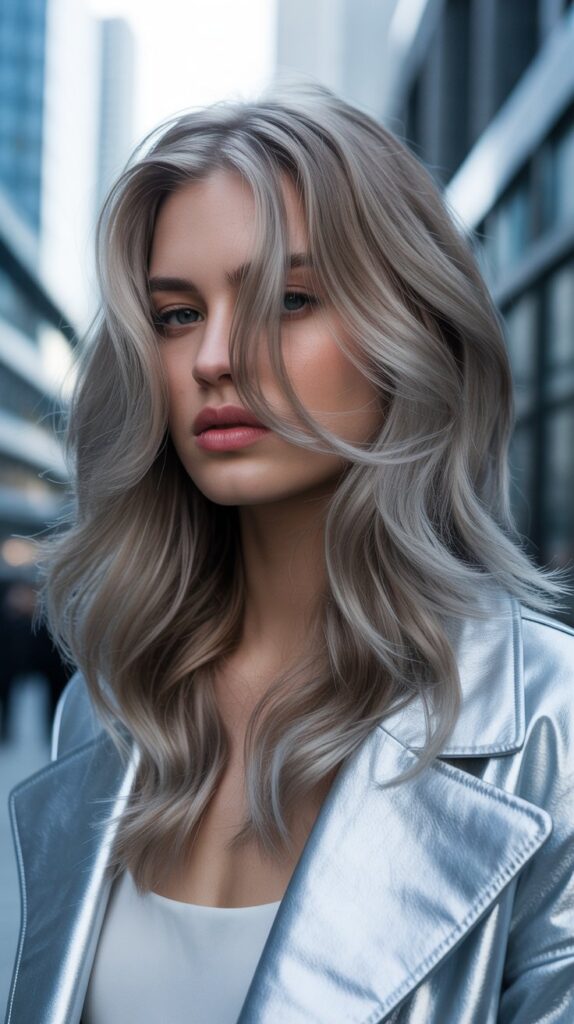
Cool blonde with silver highlights creates dimension by combining a cool ash blonde base with strategically placed silver pieces.
This sophisticated combination adds movement and texture while maintaining an overall cool tone perfect for winter.
The silver highlights catch light beautifully, creating a luminous quality that elevates the entire look beyond a single-process blonde.
- The technique involves keeping the base a cool ash blonde (level 8-9) and adding silver highlights throughout for contrast
- Cool blonde with silver highlights works exceptionally well on cool to neutral skin tones
- This style requires regular toning to maintain both the cool base and the silver highlights
- The dimensional nature creates visual interest and makes the hair appear fuller and more textured
- Maintenance includes purple shampoo and regular conditioning treatments to keep both tones vibrant and healthy
24. Warm Champagne Blonde

Warm champagne blonde takes the traditional champagne shade and infuses it with more golden warmth, creating a luxurious color that feels celebratory yet wearable.
This variation on champagne blonde leans toward the warmer side while maintaining the sophisticated, effervescent quality the color is known for.
It’s perfect for those who love the champagne concept but need more warmth to complement their skin tone.
- The shade combines pale gold with peachy and subtle pink undertones for a warm but refined appearance
- Warm champagne blonde is particularly flattering on warm and neutral skin tones with yellow or peachy undertones
- This color requires careful balancing during toning to achieve warmth without crossing into brassy territory
- Maintenance involves alternating between products that maintain warmth and those that prevent excessive brassiness
- The color pairs beautifully with winter’s warm metallic accessories, particularly gold and copper tones
25. Iced Coffee Blonde

Iced coffee blonde perfectly captures the appearance of a light iced coffee with cream, blending cool brown undertones with blonde for a unique neutral shade.
This color has become increasingly popular for its sophisticated, modern appearance that works across seasons but feels particularly appropriate for winter.
The cool-neutral quality prevents it from appearing too warm or too ashy, landing in a sweet spot that’s universally flattering.
- The shade combines light brown, beige, and cool blonde tones for a truly neutral, coffee-inspired appearance
- Iced coffee blonde works across all skin tones, making it one of the most versatile options available
- This color is relatively low-maintenance, as the combination of tones disguises regrowth and fading
- Achieving this shade requires careful color formulation to balance the cool and warm elements properly
- The neutral quality makes it an excellent choice for those who struggle with hair color pulling too warm or too cool on their particular hair
26. Opal Blonde
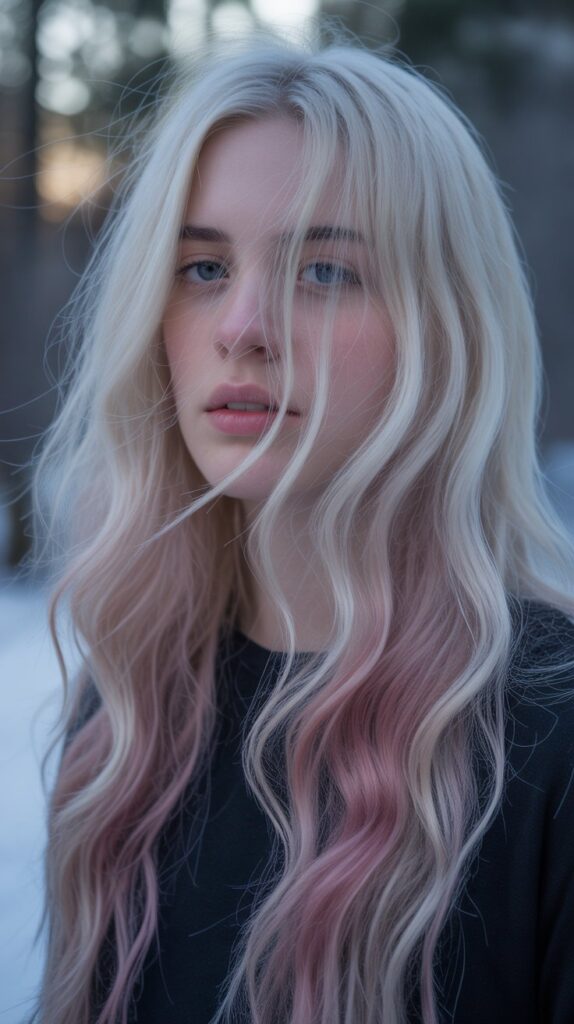
Opal blonde creates an iridescent, multidimensional effect by combining multiple pastel and neutral tones throughout blonde hair.
Named after the gemstone known for its color play, this shade shifts appearance in different lighting, showing hints of blue, purple, pink, and silver alongside blonde.
Opal blonde represents the artistic end of winter blonde colors, perfect for those who want their hair to be a statement piece.
- The color requires a very pale base (level 10+) to properly show the subtle pastel tones that create the opal effect
- Opal blonde is achieved through multiple toners and color melting techniques that layer different pastel shades
- This shade is high-maintenance, requiring frequent toning appointments and color-depositing treatments at home
- The iridescent quality photographs exceptionally well, making it popular among beauty influencers and creative professionals
- Opal blonde works best on cool to neutral skin tones that can handle the variety of undertones present in the color
27. Creamy Blonde

Creamy blonde delivers exactly what its name suggests—a soft, cream-colored blonde that’s neither too warm nor too cool.
This shade offers a gentle, approachable appearance that feels natural and effortless while still providing the lift and brightness associated with blonde hair.
Creamy blonde has maintained steady popularity because it’s wearable for everyday life while still feeling polished and intentional.
- The color features soft neutral undertones with the slightest hint of warmth, resembling fresh cream
- Creamy blonde is flattering across most skin tones, particularly those with neutral undertones
- This shade is moderately easy to maintain, requiring color-safe products and occasional glossing treatments
- Achieving creamy blonde typically involves lifting to level 9 and using carefully balanced toners
- The soft quality of this shade makes it appropriate for all ages and most professional environments
Maintenance Tips for Winter Blonde Hair
Winter presents unique challenges for maintaining blonde hair, from indoor heating that dries out strands to outdoor cold that can cause breakage. Proper maintenance during winter months ensures your chosen blonde shade remains vibrant, healthy, and beautiful throughout the season.
- Indoor heating systems dramatically reduce humidity levels, which strips moisture from hair and can make blonde shades appear dull or lifeless
- Purple shampoo remains essential for maintaining cool-toned blondes, but usage should be adjusted based on your specific shade to avoid over-toning
- Blue shampoo works better for warmer blonde shades, neutralizing orange tones without making the hair appear gray or ashy
- Deep conditioning treatments should become non-negotiable during winter, ideally incorporating them into your weekly routine
- Protecting hair from temperature extremes by wearing hats or hoods prevents breakage, though natural fiber options reduce static buildup
- Limiting heat styling during winter helps preserve hair health, as strands are already stressed from environmental factors
- Glossing treatments every 4-6 weeks refresh your blonde color, add shine, and smooth the cuticle for improved appearance
- Using a humidifier in your bedroom helps counteract the drying effects of heating systems, benefiting both hair and skin
- Silk or satin pillowcases reduce friction during sleep, preventing breakage and preserving blonde color longer
- Regular trimming every 6-8 weeks removes damaged ends and keeps blonde hair looking fresh and healthy throughout winter
Choosing the Right Blonde for Your Skin Tone
Selecting the perfect winter blonde shade requires understanding how different tones interact with your natural coloring. The right blonde should enhance your features, brighten your complexion, and work harmoniously with your skin’s undertones rather than fighting against them.
- Cool skin tones (pink, red, or blue undertones) look best with platinum, ash, silver, mushroom, icy, and pearl blonde shades
- Warm skin tones (yellow, peachy, or golden undertones) are flattered by honey, caramel, butter pecan, golden, and warm champagne blondes
- Neutral skin tones (balanced undertones) have the most flexibility and can wear virtually any blonde shade, from cool to warm
- Fair skin benefits from high-contrast looks like platinum with dark roots or can embrace soft, subtle shades like vanilla or creamy blonde
- Medium skin tones look stunning in dimensional blondes like bronde, caramel, or honey that add warmth without washing out features
- Olive skin tones should lean toward warmer blondes with golden undertones, as cool ash tones can create an unflattering clash
- Deep skin tones are beautifully complemented by rich, warm blondes like honey, caramel, and butter pecan that create striking contrast
- The vein test helps determine undertones: blue or purple veins indicate cool undertones, green veins suggest warm, and both colors indicate neutral
- Consider your eye color, as certain blonde shades can make eye color appear more vivid or create beautiful complementary effects
- Lifestyle factors matter when choosing blonde shades—high-maintenance colors like platinum require more salon visits and at-home care
Styling Tips for Winter Blonde Hair
Winter blonde hair offers unique styling opportunities that embrace the season’s aesthetic while protecting your color investment. The right styling techniques can enhance your blonde shade, add dimension, and keep your hair looking its best despite winter’s harsh conditions.
- Embrace texture through braids, waves, and loose curls that showcase the multidimensional nature of your blonde color and catch winter light beautifully
- Winter accessories like velvet headbands, jeweled clips, and silk scarves add sophistication while protecting hair from harsh weather conditions
- Sleek, straight styles work exceptionally well with icy and platinum blondes, creating a modern, polished look that reflects light dramatically
- Half-up styles showcase both your root color and lighter ends, particularly flattering for dimensional blondes like bronde or smoky blonde
- Low buns and chignons protect ends from winter damage while creating elegant looks perfect for the season’s formal events
- Beach waves might seem summery, but they work beautifully on winter blondes, creating movement that prevents flat, one-dimensional color appearance
- Root teasing adds volume at the crown, which is particularly beneficial for those with shadow roots or darker blonde bases
- Hair oils and serums applied to ends before styling add shine and protection, making blonde hair appear healthier and more vibrant
- Avoid over-washing during winter, as natural oils help protect hair from environmental damage—aim for 2-3 times weekly maximum
- Heat protectant becomes non-negotiable when styling blonde hair in winter, as the combination of processing and dry air increases vulnerability to damage
- Experiment with partings, as changing your part can reveal different color dimensions and create the illusion of more volume
- Metallic hair accessories in silver, gold, or rose gold complement various blonde shades and add winter glamour to simple styles
- Loose, undone textures align with winter’s cozy aesthetic while preventing the over-styled appearance that can look dated
- Incorporate winter-appropriate hair jewelry like pearl pins or crystal accessories that echo the cool elegance of winter blonde shades
Common Mistakes to Avoid with Winter Blonde Hair
Understanding what not to do is equally important as knowing proper blonde hair care. Avoiding these common mistakes will help preserve your color, maintain hair health, and ensure your winter blonde looks its best throughout the season.
- Over-toning is one of the most frequent mistakes, leading to muddy, gray, or purple-tinted hair that looks unnatural and unflattering
- Using the wrong purple shampoo can create unwanted tones—cool blondes need violet-based formulas while warm blondes may need blue-based products
- Skipping heat protectant causes cumulative damage that makes blonde hair appear fried, frizzy, and unable to hold color properly
- Washing with hot water opens the hair cuticle excessively, causing color to fade faster and leaving hair vulnerable to damage
- Neglecting root touch-ups for too long creates harsh lines that are difficult to blend, requiring more extensive color correction
- Using clarifying shampoo too frequently strips beneficial oils and color molecules, leaving hair dry and causing premature color fading
- Attempting extreme color changes at home without professional help often results in uneven color, damage, or shades that don’t match expectations
- Ignoring hair porosity when selecting products leads to either product buildup or insufficient moisture retention
- Wearing dark hats without protection underneath can cause color transfer and staining, particularly with lighter blonde shades
- Swimming in chlorinated pools without protection turns blonde hair green or brassy, requiring professional color correction
- Overlapping bleach applications during touch-ups causes breakage and uneven color, particularly at the mid-lengths where old and new color meet
- Using metal hair accessories or tools can cause unexpected chemical reactions with hair color, leading to discoloration or green tones
- Expecting one-session transformations from dark to platinum often results in compromised hair integrity and disappointing color results
- Forgetting about scalp care leads to dryness, flaking, and irritation that can impact hair health and growth
Budget-Friendly Alternatives for Maintaining Winter Blonde
Professional blonde maintenance can be expensive, but strategic approaches and smart product choices help extend salon visits and maintain beautiful color without breaking the bank during winter months.
- DIY toning treatments using semi-permanent color depositing conditioners can extend time between professional toning appointments by 2-4 weeks
- Purple shampoo and conditioner sets from reputable brands offer salon-quality toning at a fraction of professional treatment costs
- At-home glossing kits provide temporary shine and color refresh between salon visits for about one-tenth the cost of professional glosses
- Dry shampoo extends time between washes, preserving color and natural oils while maintaining volume and style
- Strategic root shadowing techniques allow you to embrace darker roots intentionally, dramatically reducing maintenance frequency and costs
- Balayage or ombre techniques create lower-maintenance blonde looks that grow out naturally rather than requiring frequent touch-ups
- Investing in quality heat tools with precise temperature control prevents damage that leads to costly color correction and treatments
- Making your own hair masks using ingredients like coconut oil, honey, and avocado provides deep conditioning without salon treatment prices
- Buying professional products in bulk during sales or from beauty supply stores reduces per-use costs significantly
- Spacing appointments strategically by pushing touch-ups one extra week each time gradually extends your color cycle without obvious regrowth
- Learning basic toning techniques through reputable online tutorials enables you to maintain your blonde between professional appointments
- Using color-depositing conditioners in your regular rotation maintains vibrancy without the cost of frequent professional toning
- Protecting hair from damage through silk pillowcases and gentle handling reduces the need for expensive repair treatments
- Choosing lower-maintenance blonde shades from the start, like dirty blonde or bronde, naturally reduces long-term maintenance costs
The Science Behind Blonde Hair Color
Understanding the chemistry and biology of blonde hair helps you make informed decisions about color choices, maintenance, and realistic expectations for your winter blonde transformation.
- Natural blonde hair contains lower concentrations of eumelanin (brown/black pigment) compared to darker hair types, creating the appearance of light color
- The lightening process uses alkaline agents to open the hair cuticle and oxidizers to break down melanin molecules into smaller, colorless particles
- Level system in hair coloring ranges from 1 (black) to 10 (lightest blonde), with platinum requiring level 10 and most blondes falling between 7-10
- Porosity changes occur during bleaching as the cuticle becomes more raised, causing processed blonde hair to absorb and release color molecules differently
- Toner chemistry uses semi-permanent dyes to deposit color pigments that neutralize unwanted undertones or create specific blonde shades
- Color wheel theory explains how purple neutralizes yellow, blue cancels orange, and green counteracts red—fundamental for understanding toning
- Protein structure damage happens when bleaching breaks disulfide bonds in the hair cortex, requiring protein treatments to rebuild strength
- Moisture loss accelerates in blonde hair because the raised cuticle allows water molecules to escape more easily than in virgin hair
- pH balance matters significantly for blonde hair, as alkaline products continue damaging while slightly acidic products seal the cuticle and lock in color
- Oxidation processes continue even after rinsing color, which is why blonde hair can shift tone in the days following a color service
- Environmental factors like UV exposure, chlorine, and hard water minerals cause chemical reactions that alter blonde tones over time
- Gray hair coverage works differently on blonde because gray strands lack pigment, accepting color molecules more readily than pigmented strands
- The hair growth cycle means you’ll see root regrowth at a rate of approximately half an inch per month, requiring strategic planning for maintenance
- Undertone science explains how underlying pigment in your natural hair affects the final blonde result, with orange bases requiring more neutralization
Celebrity-Inspired Winter Blonde Looks
Celebrity blonde transformations often set trends and provide inspiration for those considering winter blonde shades. These iconic looks demonstrate how different blonde tones can create distinct aesthetics and personal styles.
- Platinum ice blonde seen on style icons creates an edgy, high-fashion appearance perfect for those who want to make a bold statement
- Warm honey blonde popularized by various celebrities offers approachable glamour that works for both casual and formal occasions
- Rooted blonde styles embraced by many stars demonstrate how darker roots can add dimension while reducing maintenance requirements
- Champagne blonde frequently spotted on red carpets provides sophisticated elegance suitable for winter events and celebrations
- Ash blonde transformations show how cool tones can create a modern, fashion-forward appearance without going extremely light
- Beachy bronde proves that summery color combinations work beautifully in winter when styled with appropriate seasonal fashion
- Silver blonde movements have been pioneered by celebrities embracing gray-toned hair as a fashion choice rather than aging indicator
- Dimensional balayage techniques seen on stars create natural-looking blonde that appears expensive and carefully crafted
- Rose gold blonde phases demonstrate how trend-driven colors can be adapted to suit individual coloring and personal style
- Classic golden blonde remains timelessly popular among celebrities, proving that traditional warm blonde never goes out of style
- Ombre effects from dark to light show dramatic contrast while maintaining wearability for everyday life
- Textured blonde styles prove that the cut and styling matter as much as the color itself in creating memorable blonde looks
- Bold platinum with dark brows creates striking contrast that’s become a signature look for fashion-forward individuals
- Multidimensional techniques using multiple blonde shades prove that complexity creates the most realistic and beautiful blonde results
Transitioning to Winter Blonde from Other Colors
Moving from a different hair color to winter blonde requires careful planning, realistic expectations, and often multiple sessions to achieve desired results while maintaining hair health.
- From dark brown or black expect 2-4 sessions spaced several weeks apart to reach light blonde without causing severe damage
- The lifting process removes existing pigment progressively, with each session bringing you closer to your blonde goal
- Intermediate shades like light brown, caramel, or dark blonde often serve as necessary stepping stones in the transition journey
- Color correction may be needed if previous box dye or dark colors have caused buildup that prevents even lightening
- Olaplex or bond-building treatments should be incorporated throughout the transition process to minimize damage and maintain hair integrity
- From red hair requires careful removal of red pigment, which tends to be stubborn and may require specialized color removers
- From previous blonde makes transitioning to winter blonde shades relatively simple, often achievable in a single toning session
- Gray coverage can be incorporated into your winter blonde, with strategic placement that blends rather than hides silver hairs
- Highlight services offer a gradual approach to blonde, adding lightness progressively without the commitment of all-over color
- Lowlight additions during transition can create dimension and prevent the hair from appearing flat or one-dimensional
- Consultation importance cannot be overstated—professional colorists assess your starting point and create customized transition plans
- Realistic timelines typically span 3-6 months for dramatic color changes, requiring patience and trust in the process
- Home care between sessions becomes crucial, using color-safe products and treatments that prepare hair for the next lightening session
- Cost considerations for major transitions can range from several hundred to over a thousand dollars depending on starting color and desired result
Conclusion
The journey to finding your perfect shade among these 25+ Winter Hair Colors for Blondes: Cool, Chic, and Stunning opens up a world of possibilities that go far beyond simple blonde hair.
Winter provides the ideal backdrop for experimenting with cooler tones, embracing dimensional techniques, and discovering blonde shades that complement your unique coloring and personal style.
Whether you’re drawn to the icy drama of platinum, the sophisticated neutrality of mushroom blonde, the warmth of honey tones, or the dimensional beauty of bronde, there’s a winter blonde shade that will make you feel confident and beautiful throughout the coldest months.
Remember that achieving and maintaining your ideal blonde requires commitment to proper care, regular maintenance, and working with skilled professionals who understand color theory and hair health.
The investment in quality products, protective styling, and strategic salon visits pays dividends in the form of healthy, vibrant hair that turns heads wherever you go.
This winter, embrace the transformative power of blonde hair color and discover how the right shade can brighten not just your appearance but your entire outlook on the season ahead.
